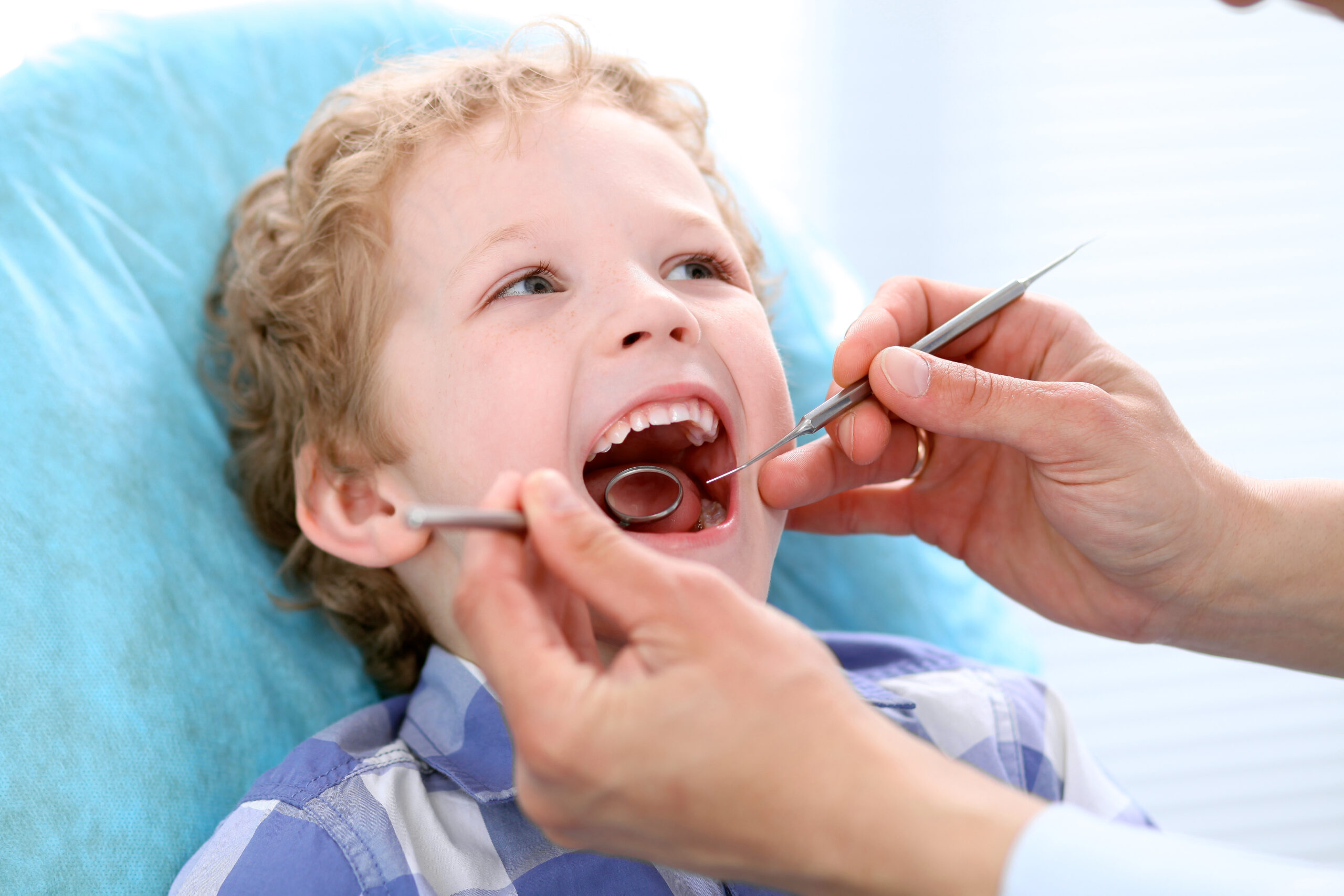Do you notice your child snoring regularly, breathing through their mouth, or waking up tired despite a full night’s sleep? These could be signs of sleep-related breathing issues that affect both their health and daily functioning. Many parents are surprised to learn that pediatric dentists play a crucial role in identifying and treating these conditions. At Little Roots Pediatric Dental, we recognize the significant impact that sleep-related breathing problems can have on a child’s development and overall wellbeing.
At our Westbury practice, Dr. Vohra and Dr. Barzideh are expanding their expertise in addressing sleep-related breathing issues to help children breathe better, sleep better, and thrive.
Understanding Sleep-Related Breathing Issues in Children
Sleep-related breathing disorders (SRBDs) include a spectrum of conditions that affect a child’s breathing during sleep, from primary snoring to obstructive sleep apnea (OSA). These issues are more common than many parents realize, affecting an estimated 10-12% of children.
Common Sleep-Related Breathing Issues
Children may experience various types of breathing disturbances during sleep:
- Primary snoring: Regular snoring without significant breathing pauses or sleep disruption
- Upper airway resistance syndrome: Increased effort to breathe during sleep, causing arousals
- Obstructive sleep apnea: Partial or complete blockage of the airway during sleep, leading to disrupted breathing and sleep fragmentation
- Central sleep apnea: Breathing pauses due to the brain not sending proper signals to the breathing muscles
Signs and Symptoms to Watch For
Children with sleep-related breathing issues may show a variety of symptoms, including:
- Habitual snoring (more than three nights per week)
- Mouth breathing during sleep or while awake
- Pauses in breathing during sleep
- Restless sleep or unusual sleeping positions
- Bedwetting beyond the typical age
- Morning headaches
- Daytime sleepiness or difficulty waking
- Behavioral issues, including hyperactivity or difficulty concentrating
- Growth concerns or weight issues
The Impact on Children’s Health and Development
Untreated sleep-related breathing problems can have far-reaching effects:
- Physical health: Potential heart issues, metabolic changes, and impaired growth
- Cognitive development: Attention problems, learning difficulties, and reduced academic performance
- Behavioral health: Increased risk of ADHD-like symptoms, irritability, and mood disturbances
- Quality of life: Fatigue affecting daily activities and social interactions
The Dental Connection to Sleep-Related Breathing Issues
Many parents are surprised to learn that dentists, particularly pediatric dentists, are often on the front lines of identifying sleep-related breathing disorders. Here’s why:
Oral and Facial Structures Matter
The development of oral and facial structures significantly impacts airway function. Pediatric dentists are trained to identify:
- Narrow dental arches
- High-vaulted palates
- Recessed chins or retrognathia (when the lower jaw is positioned behind the upper jaw)
- Enlarged tonsils or adenoids
- Tongue ties or restrictions
- Malocclusions (bite problems) that may affect airway space
These structural factors can contribute to airway obstruction during sleep, making pediatric dentists invaluable in early detection.
Early Detection During Regular Dental Visits
Since children typically see their dentist regularly for preventive care, these visits provide opportunities to screen for signs of sleep-related breathing issues. At Little Roots Pediatric Dental, we incorporate airway screening into our comprehensive examinations, looking for:
- Signs of mouth breathing
- Dental wear patterns associated with grinding (a potential compensatory mechanism for airway obstruction)
- Structural irregularities that may impact breathing
- Tonsil size and position
- Tongue position and function
How Pediatric Dentists Help Address Sleep-Related Breathing Issues
Pediatric dentists offer several approaches to addressing sleep-related breathing problems:
Screening and Referrals
Comprehensive screening during dental visits can identify children who may need further evaluation. We work collaboratively with:
- Sleep specialists
- Ear, nose, and throat (ENT) doctors
- Pulmonologists
- Myofunctional therapists
This multidisciplinary approach ensures that children receive appropriate diagnostic testing and comprehensive care.
Oral Appliance Therapy
For some children, especially those with mild to moderate sleep-related breathing issues, dental appliances may help:
- Mandibular advancement devices: These appliances help position the lower jaw forward, increasing airway space
- Palatal expanders: These devices widen the upper jaw, creating more room for the tongue and improving nasal airflow
- Habit-correcting appliances: These help address habits like thumb sucking that may contribute to oral-facial development issues
Myofunctional Therapy
Pediatric dentists may recommend or provide myofunctional therapy, which involves exercises to improve:
- Tongue positioning
- Nasal breathing
- Proper swallowing patterns
- Lip and facial muscle tone
These exercises can help strengthen the muscles that keep airways open during sleep and promote proper oral-facial development.
Addressing Contributing Factors
Pediatric dentists also work to identify and address factors that may contribute to breathing difficulties:
- Treating malocclusions (bite problems)
- Addressing restricted frenulums (tongue or lip ties)
- Recommending removal of enlarged tonsils or adenoids when appropriate
- Providing guidance on allergies and environmental factors that may affect breathing
The Benefits of Early Intervention
Addressing sleep-related breathing issues early in childhood offers significant advantages:
- Takes advantage of growth and development to guide proper airway formation
- Prevents the progression of symptoms and complications
- Reduces the potential need for more invasive treatments later
- Supports proper cognitive, behavioral, and physical development
- Improves quality of life for both children and their families
Our Approach at Little Roots Pediatric Dental
At Little Roots Pediatric Dental, we take a comprehensive, child-centered approach to addressing sleep-related breathing issues:
Thorough Assessment
Our evaluation process includes:
- Detailed health and sleep history
- Comprehensive examination of oral and facial structures
- Screening questionnaires to identify risk factors and symptoms
- Photo documentation to track development over time
Personalized Treatment Planning
We develop individualized treatment plans based on:
- The child’s specific breathing issues
- Age and developmental stage
- Overall health considerations
- Collaboration with other healthcare providers
Ongoing Monitoring and Support
Our care extends beyond initial treatment:
- Regular follow-up appointments to assess progress
- Adjustments to treatment as children grow
- Continued screening during routine dental visits
- Education and support for families throughout the process
Dr. Sunaina Vohra and Dr. Jessica Barzideh are expanding their expertise in sleep-related breathing issues to provide comprehensive care for children experiencing these problems. Their commitment to staying current with the latest research and treatment approaches ensures that children receive the most effective care possible.If you’ve noticed signs of sleep-related breathing issues in your child, don’t wait to seek help. Early intervention can make a significant difference in your child’s health, development, and quality of life. Contact Little Roots Pediatric Dental today at (516) 738-4434 or through our contact form to schedule a consultation at our Westbury, Long Island office.




